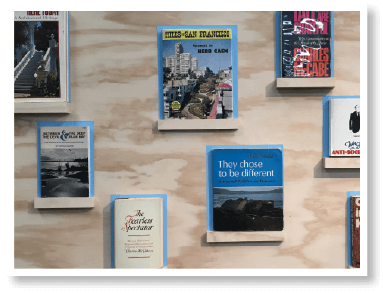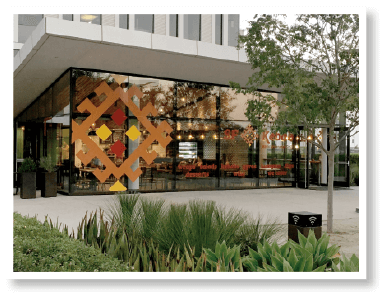
At about 8:15 a.m., I’d just begun to trudge home after dropping off my car for a windshield replacement on Bayshore Boulevard when I spotted Martita’s Kitchen – a small, slightly hidden Mexican restaurant amid the otherwise inhospitable landscape of automotive repair just south of Potrero Hill – and knew instantly that a breakfast burrito would be the thing to power me through the long walk back to civilization.
Martita’s $9 breakfast burrito is a generously stuffed cylinder of egg and chorizo, worth seeking out past the 24-hour carwash that fronts the restaurant at 2560 Marin Street, just below Cesar Chavez. With a counter, outdoor seating, and a tiny interior, Martita’s occupies the back end of the lot, serving breakfast – including American staples like omelets and bagels – and lunch – tacos, tortas, pupusas – between 8 a.m. and 3 p.m. every day but Sunday.

On the opposite side of the Hill, I visited the new free exhibit – Chronicle Books: Born in the Summer of Love, running through September 24 – at the San Francisco Center for the Book, 375 Rhode Island Street. The Center for the Book is, in its own words, “dedicated to the art of the book” as a tactile object of beauty, an increasingly significant concept as electronic formats overtake print media as transmitters of pure content. It offers classes in bookbinding, letterpress printing, and other old- and new-fashioned bookmaking methods.
The public exhibition area shares an open floor beside the machinery where artisans ply their craft. The 50th-anniversary retrospective for Chronicle Books, which started as an offshoot of the San Francisco Chronicle before making its name primarily as a producer of high-quality art books, is a natural fit for the space, allowing the local and still independent press to make a case for itself as a book design innovator while acknowledging its role as a purveyor of touristic photobooks and other paper-based gifts.
The 50 first editions on display at the Center represent a slice of San Francisco culture. They run the gamut from avant-garde endeavors to popular ones, with an emphasis on architecture, cooking, and photography. A number of books have become iconic: Griffin & Sabine, the postcard-based visual novel that was a national bestseller in 1991; Tartine Bread; Under the Tuscan Sun. But it’s more fun to look around amid the forgotten gems, like David Byrne’s inscrutable photography project Strange Ritual and San Francisco Modern, a survey of residential architecture that includes a detailed spread on the pre-renovation Schindler Residence at 20th and Wisconsin streets.

A short walk from the Center for the Book is the new Hill location of Boba Guys, the hip teahouse that opened in the spring at 1002 16th Street, below the Potrero 1010 apartment complex. To earn local support, real estate developers generally have made room for ground floor retail at their newer residential projects in and around the Hill. So far, most of these spaces are vacant. It remains to be seen whether the eclectic small businesses of our dreams – the ones that’d genuinely enrich the surrounding neighborhood – will be attracted to the spaces. For now, there’s fear that formula retail – Starbucks, Subway, Walgreens – which community guardians would likely find unacceptable on 18th Street, will eventually make its way to the relatively unprotected condominium buildings occupied by San Francisco newcomers on the Hill’s outskirts.
Only six years after its inception as a pop-up in the Mission, Boba Guys already feels a little too corporate for 18th Street. It’s definitely better than a Starbucks; its trendiness may well attract more ground floor tenants to Potrero 1010. By its own description, Boba Guys “serves the highest quality boba milk tea in the world.” It’s become a citywide phenomenon, with six stores around San Francisco, and seems to be dreaming of a nationwide chain, having already opened its first New York location.
Boba is a pearl-shaped form of tapioca over which bubble tea – a sweet, milky beverage of Taiwanese origin – is served either hot or cold. I’m no expert on boba, but Boba Guys’ drinks seem worthy of their hype. I’ve tried the soothing Classic and fragrant Jasmine Milk Tea; at the default sweetness level – which seems pretty high – they nevertheless taste far more of tea than of sugar. The shop’s modern, black-and-white interior – which includes a small bar area for on-tap “nitro tea” that can be consumed only on premises – is attractive, but feels ready-made for duplication. My recommendation is to get over there and enjoy a beverage before every upscale suburban strip mall in America has a Boba Guys and it no longer feels special, however delicious it may still taste.

Actually, I feel a little guilty already for spending three paragraphs of this column talking about what’s in some sense a chain restaurant. Which is why I want to direct you next to the hyperlocal homeware shop Industrious Life, at 1095 Tennessee Street. It seems increasingly possible that the niche boutiques and ateliers of Dogpatch represent the next step in retail’s evolution. The neighborhood contains virtually none of the traditional requirements of a business corridor – no grocery store, pharmacy, or laundromat – but there is, for example, a shop selling locally made messenger bags, another selling locally made clogs, and a few delicate, minimalist spots like Industrious Life that feel as much like arts-and-crafts galleries as they do retail spaces. Dogpatch as a whole appears to have intuited that, in the future, people will probably use the internet to do all the shopping that they don’t actually enjoy – receiving their dull, daily necessities by delivery – while brick-and-mortar stores will exist for the aesthetic pleasure of their environments, for community engagement, and for oddities that you’d have to stumble across accidentally to discover that you want them.
Industrious Life is a tribute to the tangible stuff that, in the tech era, still gets made in San Francisco, and in Dogpatch especially. It sells local pottery, local jewelry, and locally made perfumes named after French New Wave films. If your house needs something cool but you’re not sure what, exactly, it’s a great place to visit. I don’t think I’ll ever care enough about the beauty of my home to spend $60 on a Cherrywood saltbox from a Bayview-based designer, but it’s kind of nice that some people do.

Finally, to bookend my earlier breakfast recommendation, I want briefly to mention the June opening of Mission Bay’s SF Kebab, a new dinner option that previously operated under the name Hayes & Kebab before it changed neighborhoods. The Mediterranean fare – gyros, kebabs, and tabbouleh – is good and by all accounts authentic, but the restaurant design is perhaps more noteworthy. The striking building at 550 16th Street fits within the glassy geometry of its environs without succumbing to its monotony. The interior is warmer, with wooden tables and Moroccan accents, and opens onto an outdoor courtyard. The overall effect is inviting enough that SF Kebab is likely to become the first of the dining options brought to Mission Bay by the University of California, San Francisco Campus Life Services to transcend its primary function as a meal option for medical staff. Its 16th Street location makes it an easy walk from Dogpatch, open daily from 11 a.m. to 10 p.m., except on Sunday, when it closes an hour earlier.
Photos: Brett Yates

